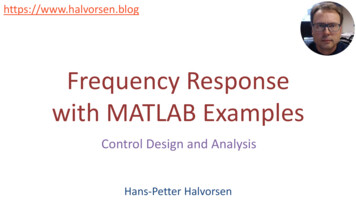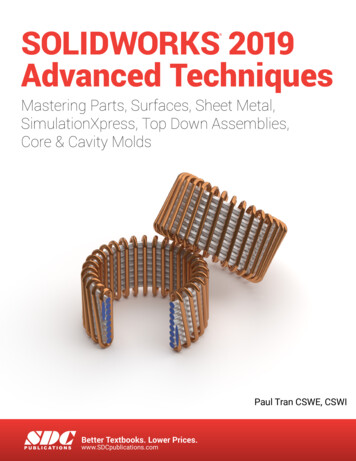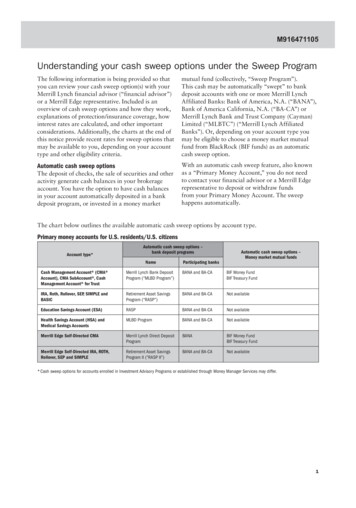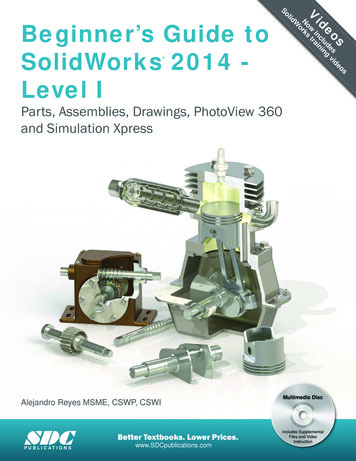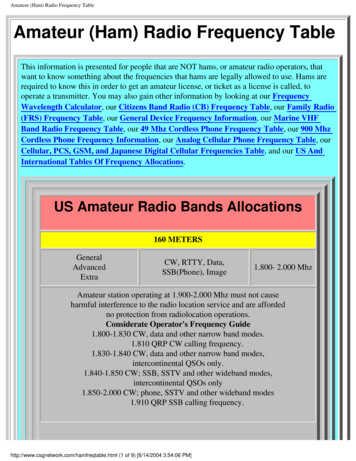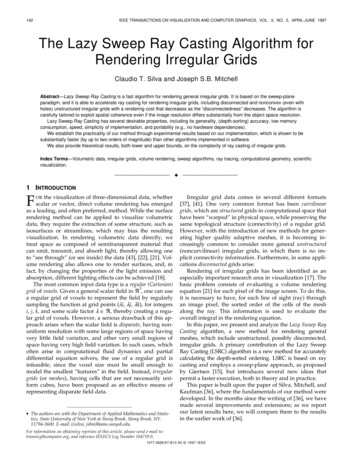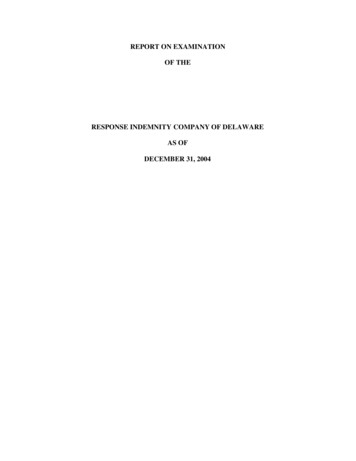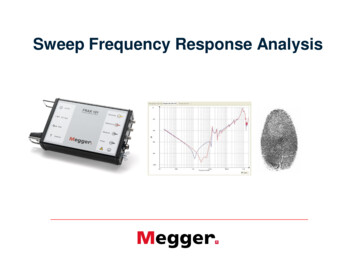
Transcription
Sweep Frequency Response Analysis
Transformer Diagnostics Diagnostics is about collecting reliable information tomake the correct decision Making the correct decisions saves moneySFRAOil analysisFDSWindingResistance
SFRA testing basics Off-line test The transformer is seen as a compleximpedance circuit [Open] (“excitation current”) and[Short] (“short-circuit impedance”)responses are measured over a widefrequency range and the results arepresented as magnitude responsecurves (“filter response”) Changes in the impedance can bedetected and compared over time,between test objects or within testobjects The method is unique in its ability todetect a variety of winding faults, coreissues and other electrical faults in onetest
Detecting Faults with SFRA Winding faults Deformation Displacement Shorts Core related faults Movements Grounding Screens Mechanical faults/changes Clamping structures Connections And more.
Comparative testsTransformer ADesign basedTime basedTransformer ATransformer BType based
SFRA Measurement philosophyNew measurement Reference measurementBack in ServiceNew measurement Reference measurementFurther Diagnostics Required
SFRA Measurements
SFRA test setup
FRAX measurement circuitry
SFRA Analysis
SFRA analysis tools Visual/graphical analysis Starting dB values for–– The expected shape of star and delta configurationsComparison of fingerprints from;––– [Open] (excitation impedance/current)[Short] (short-circuit impedance)The same transformer (symmetry)A sister transformerSymmetric phasesNew/missing resonance frequencies Correlation analysis DL/T 911 2004 standard Customer/transformer specific
Typical response from a healthy transformerHV [short] identicalbetween phasesLV [open] asexpected for a Y txVery low deviationbetween phases forall tests – no windingdefectsHV [open] as expected fora Y tx”Double dip” and midphase response lower12
Transformer with serious issues.Large deviationsbetween phases forLV [open] at lowfrequenciesindicates changes inthe magneticcircuit/core defectsLarge deviationsbetween phases at midand high frequenciesindicates winding faults13
FRAXThe Features And Benefits14
FRAX101 – Frequency Response Analyzer
FRAX101 – Frequency Response AnalyzerPower Input11-16VDC,internal battery(FRAX101)Most feature rich and accurateSFRA unit in the world!USB PortOn all On FRAX101Rugged ExtrudedAluminum CaseActive ProbeConnector on FRAX101All ConnectorsPanel Mounted
News in FRAX 2.3 SW System integrity test (as recommended in GIGRE and otherstandards) added in measurement templates and field test box FTB101 with defined response included as standard accessory Adjustable output voltage (FRAX101 and FRAX150) Extended frequency range 0.1 Hz – 25 MHz Standard (low-high) or reversed (high-low) frequency sweeps New fast and optimized default frequency sweep and detaileddescription of alternative sweep settings IEEE, IEC and VDE standard measurement templates Improved Doble and Omicron import including template data CIGRE standard *.xfra file export and import Standardized CSV export Doble export
FRAX test setupOptional Internal BatteryOver 8h effective run timeIndustrial grade class 1Bluetooth (100m)USB for redundancyEasy to connectshortest braid cables
Import formats
Fast testingLess points where it takestime to test and where highfrequency resolution is not neededMore points wherehigher frequencyresolution is usefulTraditional testabout 2 minvs.FRAX fast test 40 seconds
Unlimited analysis Unlimited graph control Lots of availablemodels/graphs e.g.magnitude, impedance,admittance, etc Ability to create customcalculation models using anymathematic formula and themeasured data from allchannels
FRAX99Same As FRAX101 except: No internal battery optionNo BluetoothDynamic range 115 dBFixed output voltage9 m cable setNo active probes
FRAX150 (Q1 2010)Same As FRAX101 except: Internal PC/stand-aloneNo internal battery optionNo active probesNo Bluetooth
FRAX product summary Light weightRuggedBattery operatedWireless communicationAccuracy & Dynamic Range/Noise floorCable practiceEasy-to-use softwareExport & import of dataComplies with all SFRA standards and recommendOnly unit that is compatible with all other SFRAinstruments
Sweep Frequency Response AnalysisApplication Examples
Time Based Comparison - Example 1-phase generator transformer 400 kV SFRA measurements before and afterscheduled maintenance Transformer supposed to be in good conditionand ready to be put in service
Time Based Comparison - Example”Obvious distorsion” as by DL/T911-2004 standard (missing core ground)
Time Based Comparison – After repair”Normal” as by DL/T911-2004 standard (core grounding fixed)
Type Based Comparisons (twin-units)Some parameters for identifying twin-units: ManufacturerFactory of productionOriginal customer/technical specificationsNo refurbishments or repairSame year of production or /-1 year for large unitsRe-order not later than 5 years after reference orderUnit is part of a series order (follow-up of ID numbers)For multi-unit projects with new design: “reference” transformer shouldpreferably not be one of the first units produced
Type Based Comparison - Example Three 159 MVA, 144 KV single-phase transformersmanufactured 1960 Put out of service for maintenance/repair after DGAindication of high temperatures “Identical” units SFRA testing and comparing the two transformerscame out OK indicating that there are noelectromechanical changes/problems in thetransformers Short tests indicated high resistance in one unit(confirmed by WRM)
Type Based Comparison – 3x HV [open]
Type Based Comparison – 3x HV [short]
Type Based Comparison – 3x LV [open]
Design Based Comparisons Power transformers are frequently designed in multi-limbassembly. This kind of design can lead to symmetricelectrical circuits Mechanical defects in transformer windings usuallygenerate non-symmetric displacements Comparing FRA results of separately tested limbs can bean appropriate method for mechanical conditionassessment Pending transformer type and size, the frequency rangefor design-based comparisons is typically limited to about1 MHz
Design Based Comparison - Example40 MVA, 114/15 kV, manufactured 2006Taken out of service to be used as spareNo known faultsNo reference FRA measurements from factorySFRA testing, comparing symmetrical phasescame out OK The results can be used as fingerprints forfuture diagnostic tests
Designed Based Comparison – HV [open]
Designed Based Comparison – HV [short]
Designed Based Comparison – LV [open]
Design Based Comparison– After Suspected Fault Power transformer, 25MVA, 55/23kV, manufactured1985 By mistake, the transformer was energized withgrounded low voltage side After this the transformer was energized again resultingin tripped CB (Transformer protection worked!) Decision was taken to do diagnostic test
Design Based Comparison– After Suspected Fault101001000100001000000-10R esponse (dBs)-20-30-40-50-60-70-80Frequency (Hz) HV-0, LV open A and C phase OK, large deviation on B-phase (shorted turn?)1000000
Design Based Comparison– After Suspected Fault101001000100000Response (dBs)-10-20-30-40-50-60Frequency (Hz) HV-0 (LV shorted) A and C phase OK, deviation on B-phase1000001000000
And how did the mid-leg look like ?Core limbInsulation cylinderLV winding
Considerations when performing SFRA TestsorHow do I maximize my investmentin time and money whenperforming SFRA measurements?
Test results – always comparisonsCore NOT groundedCore groundedRepeatability is of utmost importance!
Example of repeatability 105 MVA, Single phase Generator Step-up (GSU)transformer SFRA measurements with FRAX101 before andafter a severe short-circuit in the generator Two different test units Tests performed by two different persons Test performed at different dates
Before (2007-05-23) and after fault (2007-08-29)LV windingHV winding
Potential compromising factors Connection quality Shield grounding practice Instrument dynamic range/internal noisefloor Understanding core property influence inlower frequencies in “open” - circuit SFRAmeasurements
Bad connection Bad connection can affect the curve at higher frequencies
Good connection After proper connections were made
FRAX C-Clamp C-Clamp ensures goodcontact quality Penetrates non conductivelayers Solid connection to round orflat busbars Provides strain relief for cable Separate connector for singleor multible ground braids
Proper ground connection ensuresrepeatability at high frequenciesCIGRE grounding practice;use shortest braid from cableshield to bushing flange.Poor grounding practice
Shield grounding influenceC. Homagk et al, ”Circuit design for reproducible on-site measurements oftransfer function on large power transformers using the SFRA method”, ISH2007
FRAX cable set and groundingAlways the same ground-loopinductance on a given bushing
Instrument performance Transformers have high impedance/largeattenuation at first resonance Internal instrument noise is often the main limitingsource, not substation noise Test your instruments internal noise by running asweep with “open cables” (Clamps not connected totransformer)
Internal noise level – ”Noise floor””Open”/internal noise measurementsRed Other brandGreen FRAX101
Example of internal noise problemH1 – H2 (open & short) measurementsBlack Other brandRed FRAX101
Why you need at least -100 dB.Westinghouse 40 MVA, Dyn1, 115/14 kV, HV [open]
Influence of core Try to minimize the effect, however, somedifferences are still to be expected and must beaccepted. Preferably: perform SFRA measurements prior to windingresistance measurements (or demagnetize thecore prior to SFRA measurements) Use the same measurement voltage in all SFRAmeasurements
Run winding resistance test after SFRA!After winding resistance testAfterdemagnetization
Measurement voltage 0.1 – 10VGrey 0.1 VLight Blue 0.5 VBlue 1 VBrown 2 VBlack 5 VGreen 10 V60
Effect of applied measurement voltage2.8 VOmicron10 VFRAX, Doble and others61
FRAX has adjustable output voltage!Omicron (2.8 V)FRAX (2.8 V)62
Field Verification UnitField verification unit with knownfrequency response isrecommended in CIGRE andother standards to verifyinstrument and cables beforestarting the test
Summary – Measurement accuracy andrepeatability The basis of SFRA measurements is comparison andrepeatability is mandatory To ensure high repeatability the following is important Use of a high quality, high accuracy instrument with inputs andoutput impedance matched to the coaxial cables (e.g. 50 Ohm) Use same applied voltage in all SFRA measurements Make sure to get good connection and connect the shields ofcoaxial cables to flange of bushing using shortest braid technique. Make good documentation, e.g. make photographs ofconnections. Follow the standard recommended in CIGRE report 3422008!
SFRA – Summary and conclusions SFRA is an established methodology for detectingelectromechanical changes in power transformers Collecting reference curves on all mission criticaltransformers is an investment! Ensure repeatability by selecting good instrumentsand using standardized measurement practices Select FRAX from Megger, the ultimate FrequencyResponse Analyzer!
Transformer Diagnostics Diagnostics is about collecting reliable information to make the correct decision Making the correct decisions saves money Oil analysis SFRA FDS Winding Resistance. SFRA testing basics Off-line test The transformer is seen as a complex impedance circuit [Open] (“excitation current”
